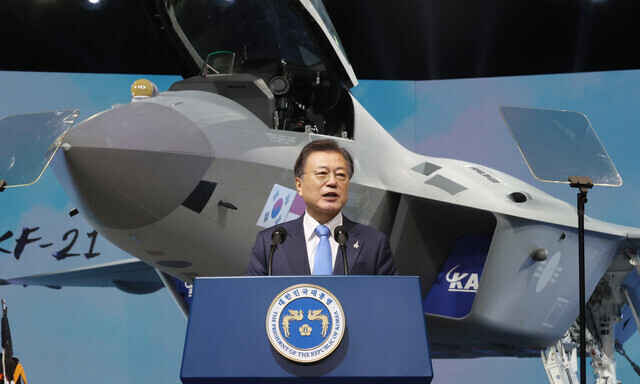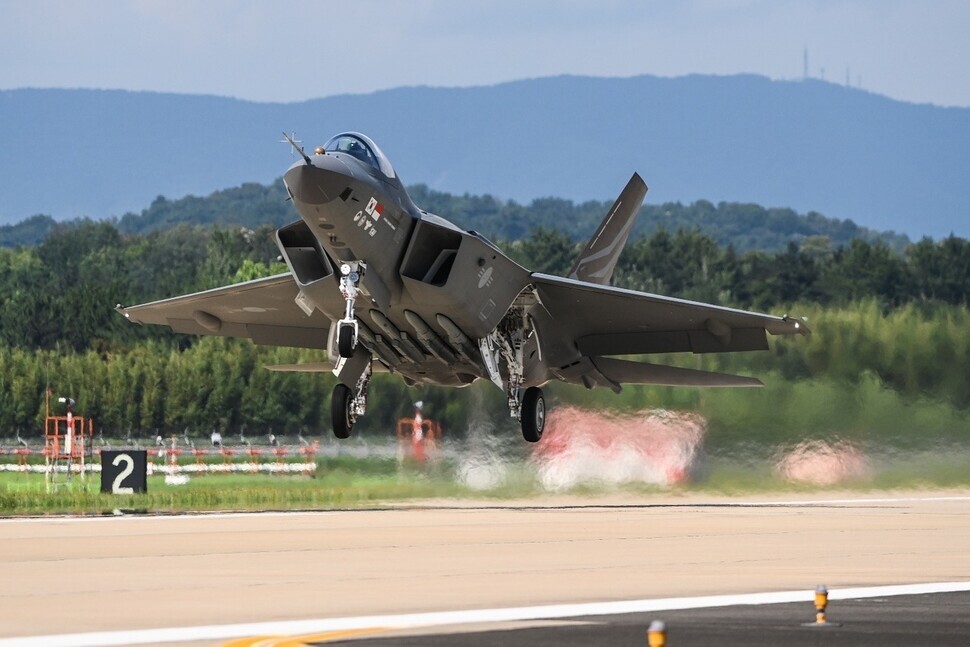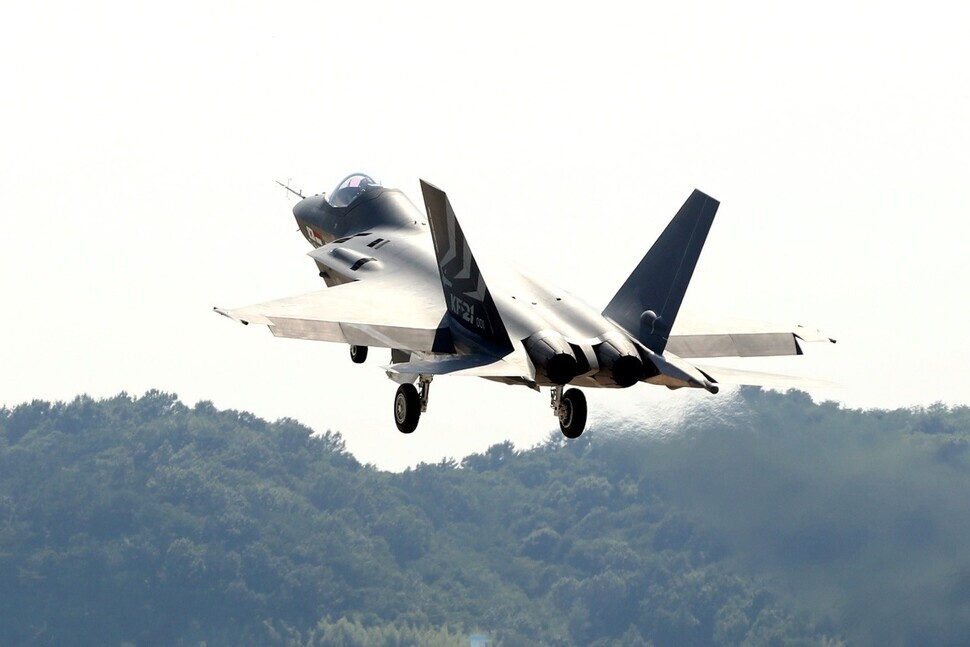hankyoreh
Links to other country sites 다른 나라 사이트 링크
Why S. Korea invested trillions of won into its homegrown KF-21 fighter jet

At 3:40 pm on July 19, 2022, Maj. Ahn Jun-hyeon, an Air Force pilot, pulled the control stick of a KF-21 Boramae, South Korea’s first homegrown fighter jet. The plane effortlessly launched into the air from the runway of the Air Force’s 3rd Flying Training Wing base in Sacheon, South Gyeongsang Province. The take-off signified that South Korea had finally caught up with similar technology around the world.
After the KF-21’s successful flight, South Korea came one step closer to becoming the eighth nation in the world to develop a supersonic fighter jet, 21 years since the country began the Korean fighter aircraft development program. So far, only the US, Russia, China, Japan, France, Sweden, and a European consortium of the UK, Germany, Italy, and Spain have successfully developed supersonic fighter jets. To mark the plane’s successful flight, the Hankyoreh compiled answers to some questions about the KF-21.

A: People who remember the KF-21 prototype unveiling ceremony which took place with great fanfare on April 9, 2021, and was attended by President Moon Jae-in ask why it took a whole year to go from unveiling to maiden flight. The prototype, which was made for performance testing purposes, was the first actual rendition of the fighter jet, which only existed in blueprints beforehand.
The prototype delivery ceremony in April 2021 was an event to mark the prototype rolling off the production line and being revealed to the public. After a prototype is made, verifications and testing can be done to make sure the model performs according to its intended design. During the past year, Korea carried out various performance and airframe structure testing with six KF-21 prototypes.
If one were to compare it to an automobile, a prototype is like a vehicle that has just come out of the factory after being assembled and has subsequently never been turned on. Just like the ignition has to work normally in order for the vehicle to be able to move and for its various apparatuses to function, a fighter jet can perform as it should only when its engine can be started. We were able to successfully start the KF-21 on April 22 last year, 13 days after the prototype release ceremony on April 9. For over a year after successfully starting the plane, we conducted tests to improve its engine output and ran it on runways at high speeds before successfully carrying out its maiden flight on July 19.
The KF-21 is made up of over 30,000 components. We also needed time to make sure the 220,000 rivets and bolts, the 7,000 structures, and the 550 pieces of electronic equipment making up the plane were working properly. The maiden flight is the beginning, not the end. With the maiden flight as the beginning, we will carry out approximately 2,200 test flights over the next four years to confirm the plane is performing as it should in various ways and verify its suitability for air-to-air armament, after which we will mass-produce Korean fighter jets in earnest starting in 2026.
Q: Some say the jet is slower than Japanese fighter jets from World War II.A:The maximum flight speed of the KF-21, a supersonic fighter jet, is 1.8 times the speed of sound (2,200 kilometers per hour). During its maiden flight, the plane flew much more slowly, at a speed of 400 kilometers per hour. A reader commented on the Hankyoreh’s Japanese article about the KF-21’s maiden flight that that’s “slower than the [Mitsubishi A6M ‘Zero’].” The Zero is a Japanese fighter jet used in World War II and has a maximum flight speed of around 600 kilometers per hour. But this kind of response stems from a misunderstanding of what test flights are for.
During the KF-21’s maiden flight on July 19, we focused on testing the plane’s ability to take off and make a landing. Prototypes are not tested for their maximum flight speed during their maiden flight. There will be roughly 2,200 test flights to come, and during the early stages, we will focus on testing how safe the plane is, such as its ability to take off and make a landing. Afterward, we will focus on improving its flight altitude, flight speed, and maneuver one by one and conduct our final verification of its flight performance and handling characteristics around 2026.

A: President Kim Dae-jung kickstarted the Korean fighter aircraft development program in August 2001, meaning it took 21 years to accomplish a successful maiden flight of the KF-21. The process took so long not only because of the difficulties of technological development but also because six out of seven project feasibility studies concerning the program concluded that it was unfeasible.
The reason was that it was unclear whether the program, which was too expensive, would succeed, and that it wouldn’t leave a profit that would match the cost. It took nine years for a project feasibility study to conclude the program was feasible, and the program kept going then stopping, going then stopping.
Experts and those in the military were skeptical of the Korean fighter aircraft development program to begin with. Those arguing against the program judged that it was unnecessary for South Korea to develop its own fighter jet by investing so much time and money when the country isn’t even the US or European countries with highly developed aviation technology. They also believed it would be cheaper and safer to buy US fighter jets that have already been verified for their performance. The Korean fighter aircraft development program is always described as “the biggest weapons project in South Korean history since Dangun.” The development cost alone has been 8.8 trillion won (roughly US$6.7 billion), after all. This cost is separate from the cost of mass-producing the fighter jets so that they can be deployed to first-line troops.
Considering the development cost, the time investment, and the expected performance of the plane, people said the program’s cost-effectiveness was too low. Those within the military and elsewhere continuously complained about the inefficiency of spending money that could buy us a high-performing Audi immediately to take the time to develop a Sonata.
The Korean fighter aircraft development program was also meant to switch out old fighter jets like the F-4 and F-5, which are 30 to 40 years old. While the program got delayed, many pilots died due to F-4s and F-5s crashing. The argument that we should “stop waiting for a Korean fighter jet to be developed and deployed god knows when and just go ahead and purchase already-verified US fighter jets” surfaced continuously.

A: The KF-21 isn’t quite at the level of a fifth-generation fighter with stealth features that prevent it from showing up on radar. It’s closer to a “4.5-generation” model with partial stealth features. Given how the US and other advanced aviation powers have been working on developing sixth-generation fighter aircraft, some have suggested the KF-21 is too old-fashioned for Korea to use for the next three decades. Even the Defense Acquisition Program Administration (DAPA) acknowledges that the KF-21 doesn’t represent the world’s top level of fighter plane.
The KF-21 is not 100% domestically developed either. The engine, which accounts for roughly 15% of the aircraft’s total price, is by the US-based company General Electric. Around 65% of the KF-21 prototype was produced with domestic components. Strictly speaking, the KF-21 is not an “independently developed Korean fighter plane,” but a fighter plane whose development was spearheaded by Korea.
So if the bang doesn’t quite match the buck, if it takes so long to make one, and if less of the finished product than hoped is actually “homegrown,” why has Korea insisted on developing its own fighter aircraft?
It’s because of how important it is to establish an independent fighter aircraft platform. When Korea purchases its fighter planes from the US, it can’t just repair the key components when they break down; it needs the US’ permission.
The “Tiger Eyes” fiasco in 2011 frequently comes up when people are talking about the importance of having one’s own platform. Tiger Eyes were a form of sensor that was placed under the F-15K’s fuselage, where it helped ensure accurate bombing even at night and in inclement weather.
In August 2011, a group of 11 investigators arrived in Korea for a visit, including the US Defense Department deputy undersecretary for arms control. They were there to investigate allegations that South Korea had attempted an unapproved disassembly of the Tiger Eyes, which were components of F-15K fighter aircraft purchased from the US.
The investigators summoned senior South Korean Air Force officials and ROK Air Force maintenance depot staff and subjected them to a grilling like something out of a criminal’s interrogation. The Air Force explained at the time that the Tiger Eyes “kept breaking down,” prompting some “servicing to check if any foreign matter had gotten into them.” But the US reportedly raked the South Korean Air Force official over the coals, with a display of bellowing and pounding on the tables and walls.

While the US objections were ostensibly about South Korea illicitly tampering with the Tiger Eyes seal, the real reasons had to do with suspicions that its aim in taking the Tiger Eyes apart was to acquire technology that it could then apply to the Korean fighter plane it had under development. The US believed South Korea was doing the same thing it had done with US-made weapons in the 1970s and 1980s, which it had taken apart and reverse engineered.
The whole controversy over breaching the Tiger Eyes seals stemmed from the principle of US weapon exports: It sells weapons, but not the technology behind them. The reason it insisted on applying that approach to Korea is that the more homegrown fighter aircraft Korea produces, the fewer fighter aircraft the US can sell it.
Once the US has sold a fighter plane, it makes additional money through component and performance upgrades. The initial acquisition cost represents only around 30% of the total operation costs over the 30 years or so that a fighter is in use; the other 70% goes toward maintenance and repairs. The restrictions on domestic servicing mean the US gets to name its own price tags for the components and repairs.
In addition to the highway robbery prices, the component and repair issue also creates major problems for Air Force combat capabilities. It can sometimes take six months to a year or more for key fighter aircraft components to arrive from the US so repairs can be carried out. When that happens, those pricey fighter planes are unable to carry out missions. The Air Force has faced severe constraints on its ability to perform duties due to shortages of repair parts for its mainstay F-15K and F-16 aircraft.
Q: Given how much emphasis President Yoon Suk-yeol has placed on the South Korea-US alliance, why is he touting the successful test flight as an “achievement in autonomous national defense”?A: With fighter aircraft, armament system upgrades cause even bigger headaches than repairs. Korea needs US permission even to test domestically produced missiles on its fighter planes.
When the US declines to grant that permission, it causes setbacks for the development of advanced weapon systems, including those related to missiles. Even the most state-of-the-art fighter is just a chunk of metal floating in the sky if you can’t load it with missiles or other weapons within a network of advanced electronic equipment.
US permission is required to test domestically produced missiles and other weapons on fighter aircraft purchased from the US. A fighter with the latest avionics equipment can’t perform at its capabilities without timely software updates.
These problems are solved when you develop a fighter aircraft domestically and establish an independent platform.
Speaking at the delivery ceremony for the Korean fighter plane prototype on April 9 of last year, then-President Moon Jae-in said, “The advantages of a domestically produced fighter plane are innumerable.”
“We can produce it and deploy it for combat whenever we need to. We can replace components and carry out repairs at any time,” he stressed.
“We can also carry out upgrades by applying state-of-the-art avionics technology to existing fighter aircraft like the KF-16 and F-15K, including the AESA radar we acquire in the development process.”
While Yoon may emphasize the importance of the South Korea-US alliance and say little about autonomous national defense, he nevertheless commented six hours after the first successful KF-21 test flight on July 19 that it represented an “achievement toward realizing autonomous national defense.” That’s how crucial it is for Korea to establish its own independent platform.
By Kwon Hyuk-chul, staff reporter
Please direct questions or comments to [english@hani.co.kr]

Editorial・opinion
![[Column] Park Geun-hye déjà vu in Yoon Suk-yeol [Column] Park Geun-hye déjà vu in Yoon Suk-yeol](https://flexible.img.hani.co.kr/flexible/normal/500/300/imgdb/original/2024/0424/651713945113788.jpg) [Column] Park Geun-hye déjà vu in Yoon Suk-yeol
[Column] Park Geun-hye déjà vu in Yoon Suk-yeol![[Editorial] New weight of N. Korea’s nuclear threats makes dialogue all the more urgent [Editorial] New weight of N. Korea’s nuclear threats makes dialogue all the more urgent](https://flexible.img.hani.co.kr/flexible/normal/500/300/imgdb/original/2024/0424/7317139454662664.jpg) [Editorial] New weight of N. Korea’s nuclear threats makes dialogue all the more urgent
[Editorial] New weight of N. Korea’s nuclear threats makes dialogue all the more urgent- [Guest essay] The real reason Korea’s new right wants to dub Rhee a founding father
- [Column] ‘Choson’: Is it time we start referring to N. Korea in its own terms?
- [Editorial] Japan’s rewriting of history with Korea has gone too far
- [Column] The president’s questionable capacity for dialogue
- [Column] Are chaebol firms just pizza pies for families to divvy up as they please?
- [Column] Has Korea, too, crossed the Rubicon on China?
- [Correspondent’s column] In Japan’s alliance with US, echoes of its past alliances with UK
- [Editorial] Does Yoon think the Korean public is wrong?
Most viewed articles
- 1‘We must say no’: Seoul defense chief on Korean, USFK involvement in hypothetical Taiwan crisis
- 2Will NewJeans end up collateral damage in internal feud at K-pop juggernaut Hybe?
- 3[Column] Park Geun-hye déjà vu in Yoon Suk-yeol
- 4Why Korea shouldn’t welcome Japan’s newly beefed up defense cooperation with US
- 5Thursday to mark start of resignations by senior doctors amid standoff with government
- 6N. Korean hackers breached 10 defense contractors in South for months, police say
- 7[Guest essay] The real reason Korea’s new right wants to dub Rhee a founding father
- 8[Column] ‘Choson’: Is it time we start referring to N. Korea in its own terms?
- 9Kim Jong-un expressed ‘satisfaction’ with nuclear counterstrike drill directed at South
- 10[Editorial] New weight of N. Korea’s nuclear threats makes dialogue all the more urgent